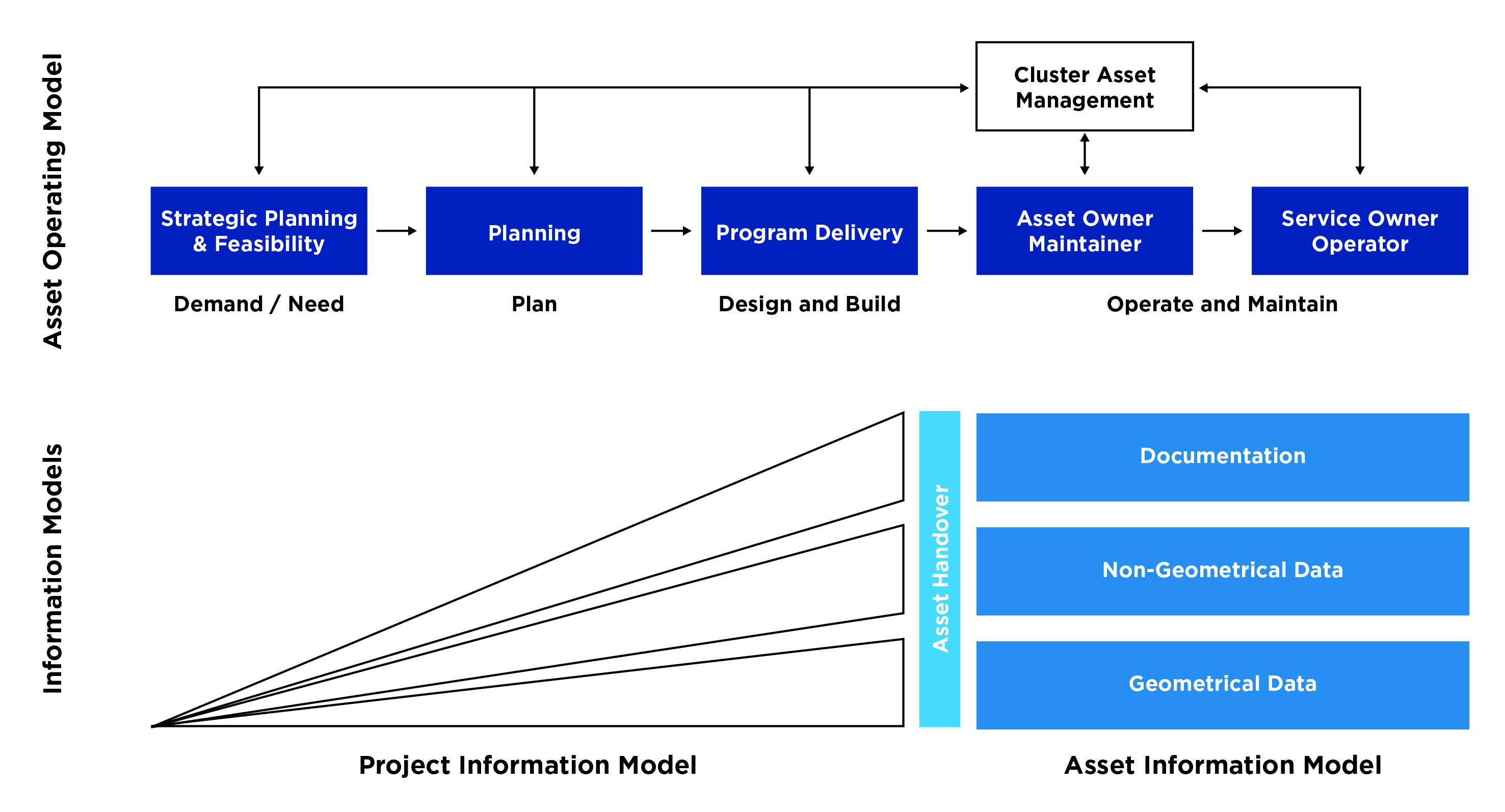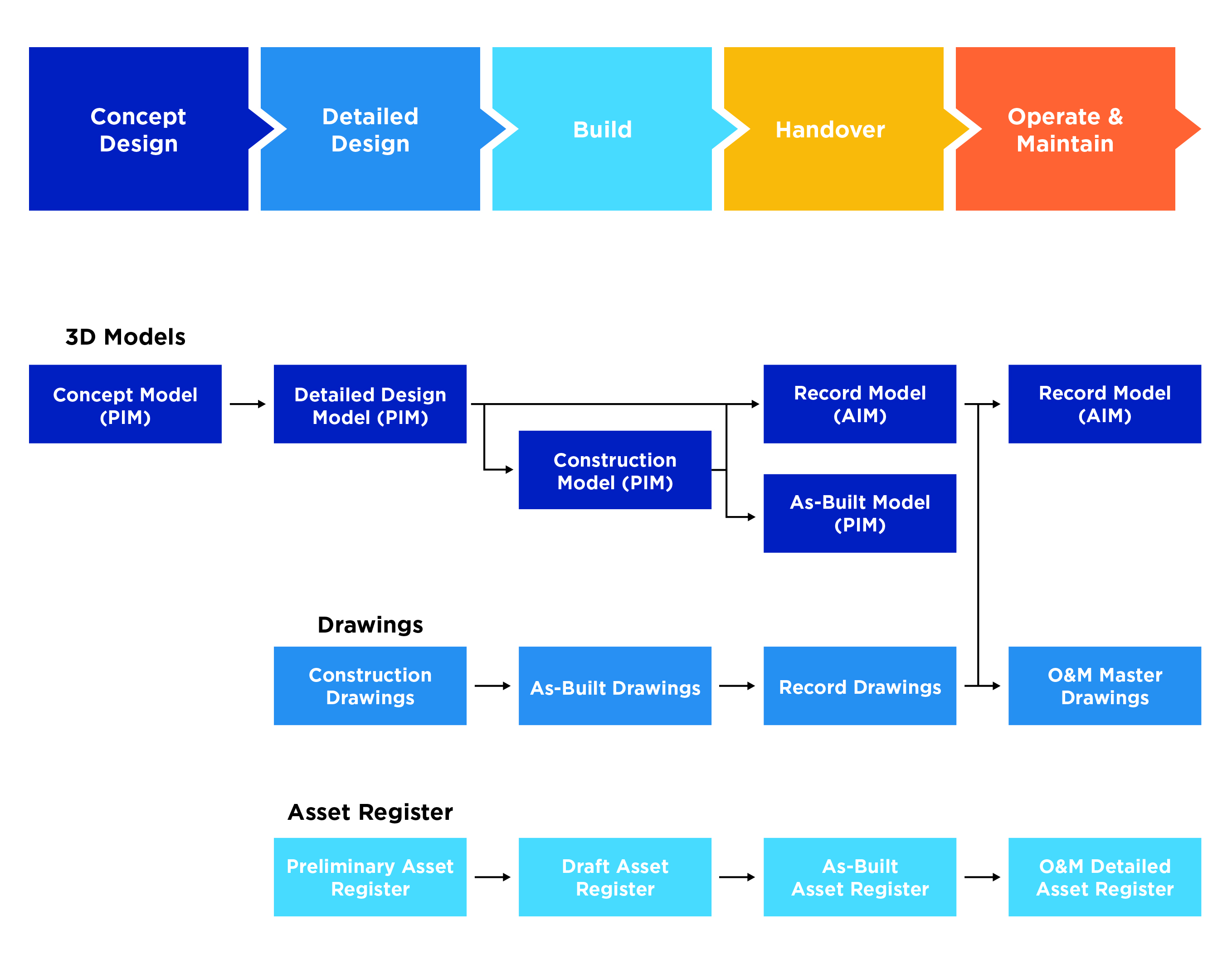The term ‘Information Model’ is a description that is used for the collation of geometrical data, non-geometrical data, and associated documentation that represent infrastructure data at various asset lifecycle stages and states.
Data is driven by the creation of the Information Models required to support the project phases as well as the Operate and Maintain Phase. A key aim of the IDMF is the continuous development of asset data and information, including the re-use from one phase of the lifecycle to the next. This continuous growth in level of detail and handover from PIM to AIM is illustrated below.

Information models provide both geometrical and non-geometrical data and information, which includes 3D models, drawings, documentation and data such as asset registers. Information models should be consistent across an agency and must be able to be applied to a single infrastructure asset or a portfolio of infrastructure assets.
Project Information Models (PIM)
The PIM supports the delivery of the project, is a major contributor to the AIM, and is a collection of structured data produced during the planning, design and construction phases of the project. It is the overarching term given to all project and asset data generated during project planning and delivery, and includes all CAD, 3D / BIM Models, GIS, time, cost, quality, risk, etc., data. Where project planning and development is outsourced, this information is produced, managed and validated by an external supplier.
The supplier must transition the PIM to the Agency at the completion of the relevant contract as a consolidated deliverable for uploading into the relevant asset owner databases. This should include all environmental and contextual data that has informed the development of the design. In addition, it is critical that the PIM also includes the information required for operations and maintenance, including information such as building and building component warranties, guarantees, testing and commissioning data, etc.
The diagram below, Figure 14, illustrates how some of the project deliverables (e.g. 3D models, drawings and asset registers) change through the different stages of the project and asset lifecycles. It also shows some of the complexities involved in transferring information from the PIM to the AIM, for example the 3D Record Model contains all the information required during Operations and Maintenance and must reflect what was built, but it does not necessarily contain all the details required for construction.
All the design details required for construction are typically not required for operations and maintenance but do need to be archived as an As-Built Model for future reference. This information is useful when an asset is renewed or re-purposed.

Based on the agency’s asset operating model and how the information requirements have been defined, each agency will need to identify whether they prefer to use a single information model for projects, or whether there are different sub-models.
Two sub-models of the PIM are outlined to align with the asset operating model structure. The PIMs are progressively developed over the duration of the project to ultimately represent the full set of data and information required to build the project, which then also provides the major input to the AIM.
Strategic Project Information Model
The strategic sub-model of the PIM supports the delivery of the demand / need phase of the project, which extends from precinct planning through to concept design, and contributes to the sub-PIM used during the next phases of the project. It is the single source of information related to an infrastructure asset or assets developed that defines the options available to the agency to meet the requirements of the demand / need phase.
This model typically covers the business requirements, risks, existing conditions of the location of the planned infrastructure development, and also includes the options for the proposed design. Smarter infrastructure development requires increased levels of digital information earlier in projects, which makes the collection of near perfect existing condition survey data more important. The level and quality of the information collected during this phase of information model development also sets the baseline for future project phases.
Plan, Design and Build Project Information Model
The Plan, Design and Build PIM supports the delivery of the project and contributes to the AIM to provide the information required to effectively support asset management and operational activities. It is the single source of information related to an asset or assets developed during planning, acquisition, design and construction of a project.
The type of information captured by a PIM includes:
- Survey data (covering from existing conditions to as-built surveys)
- Documentation
- Risks
- 2D models and drawings
- 3D models
- Schedule information, including construction sequencing
- Cost estimates and actuals
- Asset data
- Visualisations, which range from animations through to videos and photos.
The PIM needs to provide the right level of information to support construction of the infrastructure assets, and ultimately support the ability to extract the AIM.
Asset Information Models (AIM)
The AIM supports the strategic and day-to-day asset and operations management activities for both the agency (as asset owner) and operator. The AIM typically contains asset registers, maintenance planning information, cumulative maintenance costs, records of installation and maintenance dates, etc.
At the completion of the build phase, but prior to asset handover, the PIM is validated before forming the basis of the AIM. Upon compilation, the AIM must represent the asset as constructed, supplemented with the data as defined in the PIR that records the details of installation, testing and operational functional compliance
The supplier is typically required to transition all of the Operations and Maintenance (O&M) information, models and associated datasets from the PIM into the AIM.
Three sub-models of the AIM are outlined below to align with the asset operating model structure. These sub-models of the AIM are developed to support both the maintenance and operations activities, which may be provided by different suppliers.
Maintenance AIM
The Maintenance sub-model of the AIM is a model that compiles the data and information required to support asset management and maintenance. It is the single source of information related to an asset or assets, at a level required to support an agency’s asset management system.
This sub-model provides geometrical and non-geometrical data as well as relevant documentation. The maintenance AIM can be created from existing asset information systems, from newly generated information, or from information extracted from the PIM. The PIM should already contain the data requirements defined in a Maintenance Concept Document (MCD), as is typically developed for major infrastructure projects.
A maintenance AIM can include:
- Information, such as the original business requirements, i.e. what was the original design intent
- 3D models, which can be a combination of 3D spatial data of the environment and 3D design models
- Information, or links to information, about asset ownership, surveys, maintenance work that has been carried out, asset condition information, etc.
The Maintenance AIM should be managed within a CDE, which in the majority of cases, is a combination of different technology platforms including Enterprise Asset Management and GIS systems.
Operations Asset Information Model
The Operations sub-model of the AIM is a complementary set of information to the Maintenance AIM, with a specific focus on the operational aspects of delivering a service utilising the infrastructure assets as delivered by the project.
It is the single source of information related to the delivery of services utilising the asset or set of assets, with information captured at a level required to support an organisation’s operational management systems. The Operations AIM may also be derived from the data requirements defined in an Operations Concept Document (OCD) as developed for a major infrastructure project.
The Operations AIM should be managed within a CDE, which may be using the same environment as the Maintenance AIM, but in many cases will be a separate set of technology applications.
Renew / Repurpose Asset information Model
The Renew / Repurpose sub-set of the AIM is essentially an extract of information from the Maintenance and/or Operations sub-models that would be provided with an infrastructure asset that is to be renewed or repurposed. The requirements for the information to be provided in this sub-set would be determined by the early phases of a project, i.e. either the Demand / Need or Plan phase.
The Renew / Repurpose AIM would be the starting point for the creation of the next PIM as the single source of information to be handed over to a new asset owner, or to a project that is intended to renew or repurpose the infrastructure assets.
Last updated 24 Nov 2020